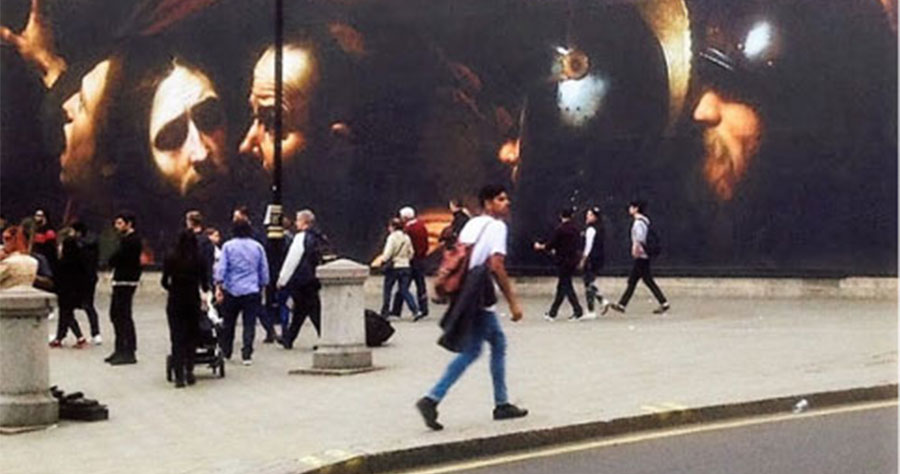An image has been haunting me for months. It was captured – or, I should say, it captured me – one September evening in Trafalgar Square. It evoked a strange sensation of timelessness, as though 2000 years had been transcended in a moment. Somehow, that historic moment of betrayal in a garden in Jerusalem in 33 AD, was present again in that iconic London meeting place in 2016 – and nobody seemed to care too much. Everyone seemed to be looking the other way. An emblem of our age?
A few days before the scene depicted by Caravaggio, the subject of the painting prophesied the terrible fate which was going to befall his city within a generation. And it did happen. The Temple was razed to the ground and the streets ran with blood.
Perhaps I should have blessed myself and prayed that this city I was now strolling through, this pivot of the modern world, would be spared a similar fate. I didn’t – even though the stones of Palmyra had recently been strewn around the Mesopotamian desert and the women of Aleppo were weeping – and continue to weep – for themselves and for their children. This morning’s paper tells us that the battle for this city is over but fears are mounting because of reports that Syrian troops or allied Iraqi militiamen were shooting people in apartments and on the streets.
The forces of militant Islam, I thought to myself, have already proven themselves no less interested in inflicting death and destruction on this city. The same great evil which was at the root of that act of betrayal, in that distant garden, is also the source of today’s horrors, is at the heart of every war.
That face, looking across Trafalgar Square, is a penetrating representation of the face of the one Person who really knows what this evil is, that its origin is a creature of enormous power and that the this creature is the irreconcilable enemy of both God and man.
That look of pity, mixed with dismay – “do you betray me with a kiss” – stopped me in my tracks. I sensed – and know – that this look is eternal. Caravaggio’s spellbinding capture of that look reminds us that each one of those figures strolling before the image is the object of the infinite love behind that gaze. A few moments before, some of them were singing and dancing on this very spot in one of those spontaneous pieces of street theatre you stumble across in this very special place.
Behind that look is the knowledge that, as Romano Guardini observed, “there is more than the mere possibility of evil as the price of human freedom; more than the inclination to evil, fruit of individual or collective (inherited) sin. Jesus recognizes a personal power that fundamentally wills evil: evil per se. It is not satisfied by the achievement of positive values through wicked means; does not simply accept the evil along with the good. Here is something or someone who positively defies divinity and attempts to tear the world from God’s hands – even to dethrone God. God being who he is, this is possible only by leading the world into apostasy and self-destruction.”
Given the look in those eyes one could not but long and long that these wayfarers might know more than they seemed to know; that they might only connect the prophetic words of that betrayed God-man with our world and its sometimes terrible predicaments. We know that humankind cannot bear very much reality and we know that singing and dancing are good for the soul – as does he, – but even just a little recognition of the divine inter-connectedness of all things would surely help?
This momentary musing on a London pavement was occasioned by the National Gallery’s use of a protective hoarding at the Gallery to advertise the “Beyond Caravaggio” exhibition currently being held there to great acclaim. This is the first major exhibition in these islands to explore the influence of Caravaggio on the art of his contemporaries and followers.
After the unveiling of Caravaggio’s first public commission in 1600, artists from across Europe flocked to Rome to see his work. Seduced by the pictorial and narrative power of his paintings, many went on to imitate their naturalism and dramatic lighting effects.
Bringing together exceptional works by Caravaggio’s and the Italian, French, Flemish, Dutch, and Spanish artists he inspired, ‘Beyond Caravaggio’ examines the international artistic phenomenon known as Caravaggism.
This exhibition is a collaboration between the National Gallery, London, the National Gallery of Ireland, and the National Galleries of Scotland. The exhibition continues in London until 15 January. It then moves to Dublin where it opens on 11 February and continues until 14 May – after which it then goes to Scotland
The image on display in the square is a detail from Caravaggio’s “The Taking of Christ”, 1602. This painting is on indefinite loan to the National Gallery of Ireland from the Jesuit Community, Leeson Street, Dublin, who acknowledge the kind generosity of the late Dr. Marie Lea-Wilson who gave them this masterpiece as a gift.
About the Author: Michael Kirke
Michael Kirke is a freelance writer, a regular contributor to Position Papers, and a widely read blogger at Garvan Hill (www.garvan.wordpress.com). His views can be responded to at mjgkirke@gmail.com.

